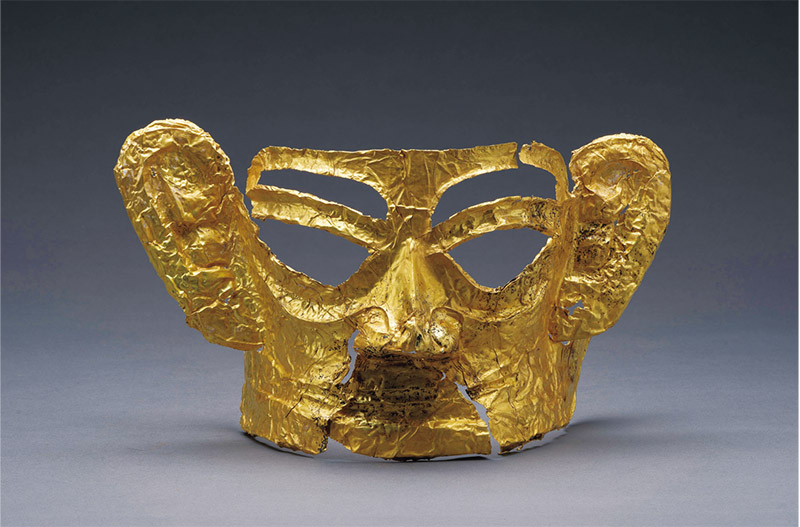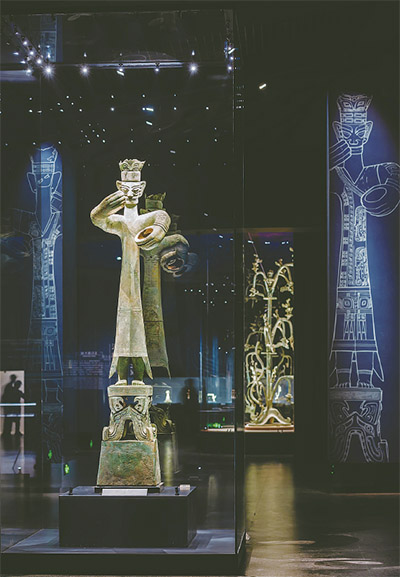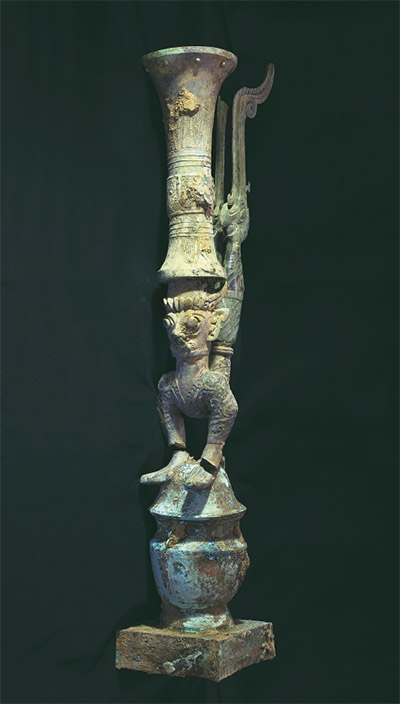A vivid example of the pluralistic unity of Chinese civilization
Sanxingdui Museum
Sanxingdui Museum, located in the northeast corner of Sanxingdui Site, is a large-scale modern thematic site museum in my country. It collects and displays the cultural relics unearthed from Sanxingdui Site and No. As “one of the greatest archaeological discoveries of mankind in the 20th century”, the Sanxingdui site has a large-scale ancient city, rigorous and elegant functional divisions, splendid artifact groups, mysterious and magnificent plastic arts and its inherently mature etiquette regulations. The fog of history outlines the romantic picture of the ancient Shu civilization, which is a vivid example of the multi-integration pattern of Chinese civilization.
Sleep for three thousand years, wake up and startle the world
In June 2021, when archaeologists slowly took out a piece of bronze shard from the “Sacrificial Pit” No. 3 of the Sanxingdui Site, a mass of severely crushed gold artifacts appeared in front of people’s eyes. When it was unearthed, this gold utensil was like a piece of manuscript paper that was crumpled into a ball, and its shape was difficult to distinguish. After restoration, a complete golden mask slowly appeared. This golden mask as thin as butterfly wings is 37.2 cm wide, 16.5 cm high, and weighs about 100 grams. It has hollow eyebrows and eyes, rounded ears, a high nose bridge, a large and slightly open mouth, and a majestic and sacred shape. The most complete piece of gold mask unearthed. This major archaeological discovery once again shocked the world.
The new round of archaeological excavations at the Sanxingdui site, which began in 2019, has made a series of major progress. Several new “sacrificial pits” have been discovered. the spiritual world. Among them, pit No. 3 is full of ivory piles, bronze, jade, and gold artifacts are magnificent, and rare cultural relics such as the kneeling figure on the top and the largest bronze mask have been successively extracted and unearthed; the jade cong with typical characteristics of Chinese civilization was extracted and unearthed in pit No. It confirms the early cultural exchanges and interactions between Sanxingdui and Gansu. The huge gold mask unearthed in Pit 5 shows the splendid splendor of Sanxingdui culture. Pit 6 was extracted as a whole, and extremely rare wooden boxes were found; the northeast corner of Pit 7 was found. A turtle-shaped grid was found; a large bronze altar was found in Pit No. 8. After carbon 14 dating, except for pits 5 and 6, the burial ages of the other pits are basically the same, about 3200 to 3000 years ago, belonging to the late Shang Dynasty.
“The famous district of Guanghan, the old soil of Luocheng… Its east is full of Dendrobium springs, and its west is accompanied by three moons.” Sanxingdui site is located in Sanxingdui Town, Guanghan City, Sichuan Province, on the south bank of the Jianjiang River (Yazi River), a tributary of the Tuojiang River in the northern Chengdu Plain. The three undulating and connected loess mounds at the southern end of the central area and the Moon Bay platform in the north, which is shaped like a crescent moon, together form the famous landscape of Guanghan – “Three Stars Accompanying the Moon”. In 1929, a farmer accidentally discovered more than 400 pieces of exquisite jade tools in a pit while digging a ditch on the Yueliangwan platform in Sanxingdui, Guanghan. Opened the prelude to the archaeology of the Sanxingdui site. In the early 1980s, Sanxingdui excavators named all the sites belonging to the same site group as “Sanxingdui Sites” based on the data obtained over the years, and conducted a phased study for the first time. In 1986, the discovery of the “Sacrificial Pit” No. 1 and 2 of the Sanxingdui Site made the legend of ancient Shu history, which has been indistinguishable since ancient times, become a true history. The Sichuan Provincial Institute of Cultural Relics and Archaeology and the Sanxingdui Museum have carried out large-scale archaeological exploration, trial excavation and investigation work at the Sanxingdui site and its surrounding areas, and have made a series of major breakthroughs – confirming the Qingguanshan platform as the highest-level construction area with a “palace” nature The layout, construction and evolution process of the city site have been gradually clarified, and the staging and chronological sequence of the site have been gradually improved… In 2019, in the “Archaeology China” major project of the State Administration of Cultural Heritage and the “Ancient Shu Civilization Protection and Inheritance Project” organized and implemented by Sichuan Province With the support, the comprehensive exploration and key excavation of the Sanxingdui site have been launched again, and significant progress has been made. As of May 2022, nearly 13,000 numbered cultural relics have been unearthed, including gold masks, bronze square statues, bronze altars, and jade cong with divine tree patterns.

The picture shows the golden mask of the late Shang Dynasty. Photo courtesy of Sichuan Provincial Institute of Cultural Relics and Archaeology
The Sanxingdui site covers an area of 12 square kilometers, and the core area is about 3.6 square kilometers. General Secretary Xi Jinping pointed out that the major achievements of our country’s archaeological discoveries have proved our country’s millions of years of human history, 10,000 years of cultural history, and more than 5,000 years of civilization history. Archaeologists excavate the buried ancient remains, reveal the dusty history, and transform their interpretation and understanding into new historical knowledge. The general secretary emphasized: “The exploration of the origin and formation of civilization is a complex and long-term systematic project, and it is necessary to organically combine archaeological exploration and literature research with natural science and technological means, and comprehensively grasp the factors such as material, spiritual and social relationship patterns. Gradually restore the development process of civilization from trickling streams to the confluence of rivers.” The archaeological discoveries of Sanxingdui have greatly made up for the shortcomings of the lack of ancient documents, showing the uniqueness and creativity of the ancient Shu civilization, as well as the close connection with other ancient civilizations in China. The important status of ancient Shu civilization as a component of Chinese civilization.
Witness the splendor of Chinese civilization
Archaeological remains and historical artifacts are witnesses to history. General Secretary Xi Jinping pointed out that the major achievements of my country’s archaeological discoveries fully demonstrate that my country is at the forefront of the development of ancient civilizations in the Neolithic Age, Bronze Age, Iron Age and other ages. The number of cultural relics unearthed at the Sanxingdui site, the variety, the large shape, the strange shape and the rich cultural connotation are rare in the world, reflecting the brilliant achievements of the ancient Shu ancestors in art and technology.

The picture shows the bronze statue of Dali in the late Shang Dynasty. Photo courtesy of Sanxingdui Museum Zhang Yan / Photo
The bronze Dali figure is 180 cm high and 260.8 cm high. It has a history of more than 3,000 years. It is the tallest and most complete bronze standing figure in the world and is known as “the king of bronze statues in the world”. The figure wears a high crown on the head, the arms are slightly encircled in front of the chest, the hands are hollow in the shape of the hands, the feet are wearing ankle bracelets, the bare feet are standing on the square monster seat, and the three layers of clothing with narrow sleeves and half arms are worn. , The decorations on the clothes are complex and exquisite, mainly with dragon patterns, supplemented by bird patterns, insect patterns and eye patterns, etc., and the body is decorated with checkered belts. The overall image of the statue is solemn and solemn. It is inlaid and cast by the segmented casting method. It is shaped according to the height, proportion and movement of the real person. The eyes, ears and hands are greatly exaggerated, so as to strengthen the extraordinary side of the portrait and the production is exquisite. Delicacy is rare in the Xia, Shang and Zhou archaeological history.
The peculiarly shaped cultural relics show the perfect combination of the ancient Shu people’s rich imagination and exquisite handicraft technology. The bronze vertical-eye mask dubbed “clairvoyance and downwind ears” is named for the exaggerated shapes of the eyes and ears. It is huge, with prominent outline and exaggerated facial features, 138 cm wide and 66 cm high. The surreal shape makes this statue reveal a mysterious quiet, majestic and upright atmosphere, giving people a strong sense of deterrence. No. 1 Bronze Sacred Tree, unearthed in 1986, is 396 cm high. It consists of three parts: base, tree and dragon. It is cast by segmented casting, using sleeve casting, riveting, and embedded casting. The largest piece of all bronze relics. The statue of the god tree has three layers of branches and leaves, and each layer has three branches. The flowers and fruits of the branches are either upturned or drooping. There is a bird standing on the flowers and fruits of the three upturned branches, there are nine birds in total (that is, the sun bird), and a dragon is hanging from the lower part.
The Sanxingdui site also unearthed a large number of gold products, jade ritual vessels and pottery, all of which showed a high level of technology. Archaeological findings also show that the buildings in the Sanxingdui site are unique, and functional areas such as sacrificial areas, ordinary residential areas, and handicraft workshop areas in the city site are distributed in an orderly manner. Numerous house building sites indicate that a large number of ancestors lived there for a long time. These houses have three forms: square, rectangle, and circle, and most of them are rectangle and square. Its construction method is to dig trenches on the ground, use small wooden sticks and bamboo sticks as walls in the trenches, and smear grass and mud on both sides to form walls, and then the walls are grilled by fire, and tenon beams and frames are placed on the top. The roof has strong regional characteristics of ancient Shu. These archaeological discoveries show that the Sanxingdui area, as an important economic, political and cultural center in the ancient Shu era, created a prosperous social and cultural life.
General Secretary Xi Jinping pointed out: “In the long history of civilization development of more than 5,000 years, the Chinese people have created a dazzling Chinese civilization and made great contributions to the progress of human civilization.” The Sanxingdui site is undoubtedly one of the shining stars. It fully demonstrates the diversity and richness of Chinese civilization.
Empirical evidence of the pluralistic unity of Chinese civilization
The huge city walls, palace areas, sacrificial areas, dense living areas, residential areas, workshops and a large number of precious cultural relics, as well as the distribution patterns of the surrounding ruins, shone the dawn of early civilization. The richness of cultural relics and the distinctive features of the Sanxingdui site show that it is one of the ancient civilization centers in the upper reaches of the Yangtze River.
No. 8 “Sacrificial Pit” newly discovered a bronze figure with a snake body on top, which was successfully matched with the remnants of the bronze bird-footed figure unearthed in No. 2 “Sacrificial Pit” in 1986. Statue of God. The statue has protruding eyes and fangs, wearing a horn mask, with both hands resting on a bronze pot with a square seat, and a cinnabar-painted goblet-shaped statue on its head. The bronze figures have the characteristics of the ancient Shu civilization, the bronze ware with the square seat is the representative of the pre-Zhou culture, and the Zun is the representative of the Central Plains culture. The combination of these three cultural factors on the same object vividly reflects that the ancient Shu civilization is an important part of the Chinese civilization.

The picture shows a statue of a god with a bowed body and a bird’s foot in the late Shang Dynasty. Sichuan Provincial Institute of Cultural Relics and Archaeology for Tulu Haizi / photo
The majestic and solemn statues, the masks that stretch out thousands of miles, the sacred tree that communicates the heaven and the earth, the mysterious altar… These rich and colorful bronzes with the characteristics of ancient Shu culture have become a branch of the bronze civilization of Xia and Shang in China. The characteristic and complex cultural landscape is a vivid example of the diversity and openness of the early stages of Chinese civilization. Judging from the unearthed artifacts, bronze medallions, copper bells, pottery pheasants, and tooth-shaped utensils are typical artifacts of the Central Plains Xia culture. The early Sanxingdui pottery pheasants and the early Erlitou pottery pheasants have little or no other than pottery quality and size. Differences; bronze statues, copper pots, copper pots, etc. are typical artifacts of Shang culture. The dragon and tiger statues in Sanxingdui are very similar in theme and cultural connotation to those in the Yin Ruins in Anyang, Henan Province. Ge has been found in Henan, Shaanxi, Shandong and the vast South China; jade cones, jade cong, etc. have the characteristics of the Liangzhu culture in the lower reaches of the Yangtze River. From the aspects of smelting technology, casting technology and methods, as well as the polishing and detailing of bronze ware, although there is a certain gap between the sophistication of Sanxingdui bronze ware and the bronze ware in the Central Plains of the same period, the welding, fan casting, claw casting and forging used in the The craftsmanship such as beating reflects that the ancient Shu people have accepted the influence of the Central Plains culture and mastered the bronze casting technology proficiently.
The dragon is the symbol of the Chinese nation. A large number of dragon-shaped objects have been unearthed at the Sanxingdui site, such as dragons hovering on bronze sacred trees, dragon-shaped objects similar to goats, dragons with tiger heads and tiger heads, pig-nosed dragon-shaped objects, and a large number of dragon-shaped objects of various shapes and sizes. decoration, etc. The concepts and basic shapes of dragons are undoubtedly derived from the culture of the Central Plains and the Yangtze River Valley. Although the images of various dragons unearthed from the Sanxingdui site are different from the Hongshan culture, the jade dragons and bronze dragons in the Central Plains, they also reflect Out of the convergence in self-identity, ritual religion and so on. In addition to the cultural relics visible to the naked eye, archaeologists have also discovered “traces” of silk at the Sanxingdui site through modern scientific and technological means, filling the gap of no silk objects in the Xia and Shang dynasties in the southwest. As we all know, in the process of the integration of Chinese civilization, silk is a very significant factor of convergence. Whether it is myths and legends about silk, historical records, or archaeological discoveries, it shows that ancient Shu and Central Plains both upheld roughly the same knowledge system and values. system.
The towering tree must have its roots; the water that embraces the mountains must have its source. The Chinese civilization is diverse, but the evolution of Chinese civilization is not the mutual extinction of multiple civilizations, but the integration of each other. The long and continuous Chinese civilization is like a towering tree cultivated in fertile soil of history. General Secretary Xi Jinping pointed out that it is necessary to closely combine the research on the origin of Chinese civilization with the research on major issues such as the characteristics and forms of Chinese civilization, and in-depth research and interpretation of the development direction of the Chinese nation’s community and the evolution pattern of the pluralistic unity of the Chinese nation indicated by the origin of Chinese civilization. Archaeological discoveries at the Sanxingdui site show that the ancient Shu civilization was a highly developed ancient civilization based on the highly developed Neolithic culture in the Chengdu Plain, absorbing and condensing the essence of the civilizations in the Central Plains, Northwest China and the Yangtze River Basin. The close cultural connection between this ancient civilization and other parts of the country has witnessed the exchange and integration of civilizations in different regions of China.
General Secretary Xi Jinping emphasized: “Historical and cultural heritage not only vividly describes the past, but also profoundly affects the present and the future; it belongs not only to us, but also to future generations. Protecting and inheriting historical and cultural heritage is responsible for history and the people. We It is necessary to strengthen archaeological work and historical research, so that the cultural relics collected in museums, the heritage displayed on the vast land, and the characters written in ancient books can all come alive, enriching the historical and cultural nourishment of the whole society.” Sanxingdui Museum will continue to promote the protection and utilization of cultural relics and cultural heritage protection and inheritance, explore the multiple values of cultural relics and cultural heritage, disseminate more value symbols and cultural products that carry Chinese culture and Chinese spirit, and create a strong social atmosphere for inheriting and promoting Chinese civilization.
This article is reproduced from: http://www.qstheory.cn/dukan/qs/2022-07/16/c_1128830524.htm
This site is for inclusion only, and the copyright belongs to the original author.